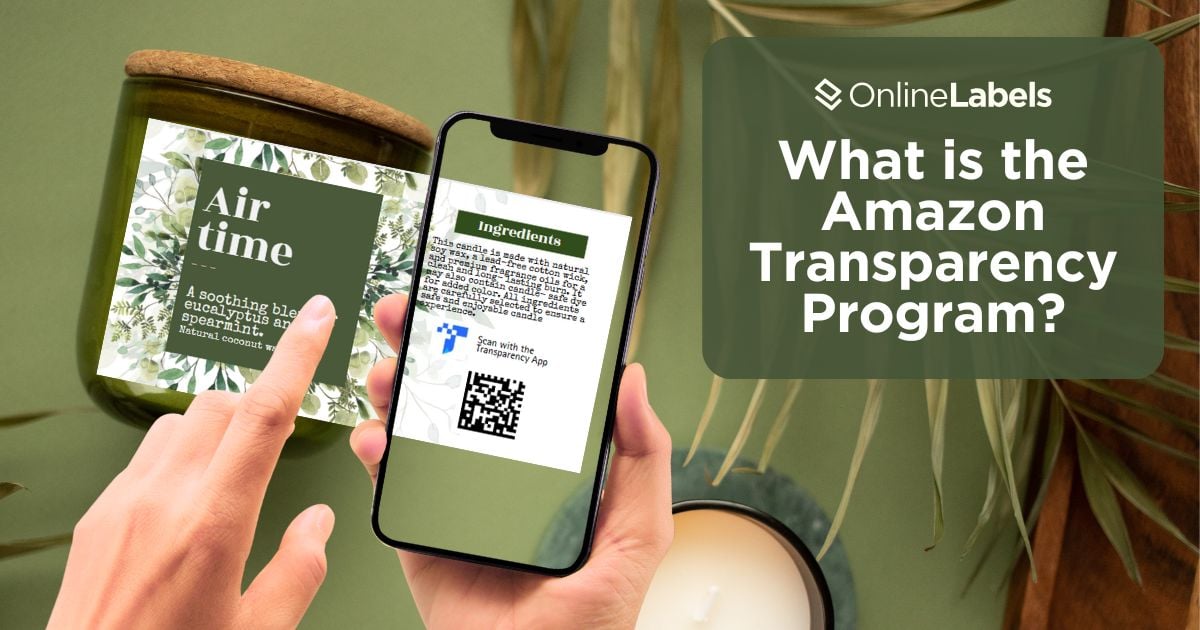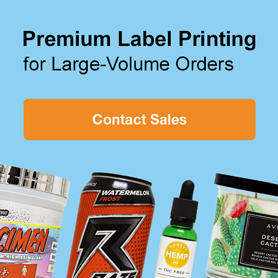Will Your Company Benefit from the Amazon Transparency Program?

As e-commerce expands, brands are increasingly at risk of counterfeit scams. This is particularly seen on Amazon, where sellers can list products without the brand's consent, damaging the original brand's trust and reputation. To help protect your company's integrity, Amazon created the Transparency Program, and in this guide, we'll walk you through everything you need to know to prepare your labels for enrollment, provide our Amazon Transparency labels, and tips for packaging.
What is the Amazon Transparency Program?
Amazon's Transparency Program is a product authentication service that assigns each item a unique, scannable 2D barcode. This code allows Amazon and customers to verify the authenticity of a product before it is shipped, helping prevent counterfeit goods from reaching buyers. When a brand enrolls in this program, it must apply these codes to every unit it manufactures. Amazon then scans the codes during the fulfillment process to confirm their authenticity. Suppose a product arrives at an Amazon fulfillment center without a valid Transparency code. In that case, it may be flagged, investigated, or withheld from shipping, plus the company might lose its right to sell. This added layer of protection is especially valuable for private label and registered brands seeking to protect their reputation and deliver a reliable customer experience.
Where Do Transparency Codes Go on the Package?
These labels are typically placed in three areas:
1. Above the price code

2. Near the QR code

How to Print Amazon Transparency Labels Yourself
Printing your Transparency labels can help facilitate your workflow and give you more control over your current label designs. However, Amazon provides two ways to generate Transparency codes that you can print on demand. For each method, you will need access to a thermal transfer printer and the appropriate roll labels.
Transparency In-Plant Printing (IPP)
Using Amazon's Self-Serve portal, you can download PDF images of your labels to print as needed.
Third-Party Label Printing Software
Companies can also use third-party printing software to print their labels, which helps import Transparency codes and print a 2D Matrix code. Any software implemented would require a thermal transfer printer (300 dpi or greater).
Amazon Transparency Compatible Roll Labels
We offer the following sizes on 1" and 3" core roll labels to print Amazon Transparency labels:
RL4625 1.75" x 0.75" - 1" core
RL6248 1.375" x 1.375" - 1" core
RL7229 1.125" x 1.125" - 1" core
Which Businesses Benefit From the Amazon Transparency Program?
The Amazon Transparency Program is designed to protect brands of all sizes, but it can be especially valuable for specific types of businesses:
Established Brands with a Trademark
Well-known brands are often targets for counterfeiters. If you've already registered your trademark and enrolled in the Amazon Transparency Program, blocking illegitimate products before reaching customers adds another security layer.
Businesses with Omnichannel Distribution
Transparency codes can help protect your products across multiple channels, even if you sell through your website or other retailers. Customers can scan the codes to check for authenticity, which gives peace of mind that the products come from the provider.
Businesses Facing Counterfeit Issues
Transparency can be a proactive solution if your brand has previously dealt with unauthorized sellers or fake listings. It allows Amazon to identify and stop counterfeit units from being sold under your listing.
What Are the Eligibility Requirements for the Amazon Transparency Program?
Before starting your journey with the Amazon Transparency Program, brand owners must meet specific eligibility criteria to ensure they can comply with the program's requirements and effectively protect their products.
Here are the requirements you need to know to see if you qualify:
- Brand ownership: you must be the registered brand owner of the products you wish to enroll.
- Amazon Brand Registry Enrollment: your brand must be enrolled in Amazon's Brand Registry, which helps verify your intellectual property rights. This requires a registered trademark, proof of trademark ownership, and a catalog of your products.
- Global Trade Item Numbers (GTINs): each product you enroll must have a valid GTIN, such as a UPC, EAN, or ISBN. This allows Amazon to identify and track your product listings correctly.
- Ability to apply Transparency codes: you must apply a unique Transparency code to every unit of each enrolled product. This includes updating packaging workflows and using code labels that meet Amazon’s scanning standards.
Advantages and Challenges of the Transparency Program and How to Overcome Them
The Amazon Transparency Program offers powerful brand protection but comes with potential inconveniences. Knowing these upfront can help you decide whether it’s the right fit for your business.
Advantages of the Amazon Transparency Program
1. Protection from Hijackers
The program prevents fake or unauthorized products from being sold under your listing. Amazon verifies each unit’s Transparency code before fulfillment, blocking all the products without it.
2. Helps for Better Organization
With this system, you can track products and improve quality control, inventory, and tracking issues.
3. Multichannel Protection
Transparency codes are not limited to Amazon. You can apply them to units sold through your website or other retailers, allowing you to protect your brand across all sales channels.
Challenges and How to Overcome Them
1. Managing Label Application at Scale
When a company joins the Amazon Transparency Program, it must apply the code to every product unit, which can complicate your packaging process.
Solution: start by enrolling one product line first to serve as an experiment.
2. Additional Cost on Production
Transparency labels can add new expenses to your packaging and operations.
Solution: factor these costs into your product pricing strategy. Many brands find the investment pays off through reduced counterfeit losses and improved customer retention.
3. Manufacturer Communication Problems
Overseas or third-party manufacturers may not be familiar with the requirements.
Solution: provide clear instructions and samples. Consider printing codes domestically and shipping them to your manufacturer, or choose partners with experience supporting Amazon sellers.
Protect Your Brand with the Transparency Program
Safeguarding your brand with Amazon's Transparency Program offers a reliable way to keep your brand from counterfeiters. Understanding the eligibility requirements and correctly preparing Amazon Transparency labels can help you follow Amazon's security policies and build customer trust. Also, if you want to learn more about how to add a barcode to your labels, check out our guide on Comparing 1D and 2D barcodes and learn how to incorporate barcodes into your packaging.


